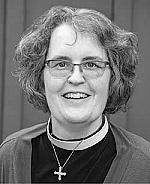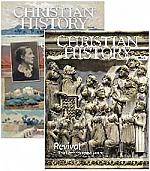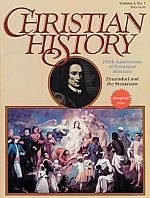Did you know? Best of CH

[James Montgomery Flagg, Caricature of G.K. Chesterton, 1914—Public domain, catholicinsight.com]
How could we possibly narrow down the most memorable “Did you know?” facts from 150 issues of CH? We did our best! Here are only a handful of our favorites.
#2 Benjamin Franklin printed John Wesley’s sermon “On Free Grace” and several sermons by Wesley’s friend and fellow preacher George Whitefield. In turn Wesley read everything Franklin wrote on the physics of electricity, then wrote his own treatise on electricity. The two men never met!
#5 Facing arrest as an Anabaptist, Dirck Willems fled for his life across a frozen lake. When his pursuer broke through the ice, Willems gave up his chance to escape by turning to save his persecutor. He was then captured, imprisoned, and burned at the stake in 1569.
#8 As part of his daily devotions, Jonathan Edwards rode his horse into the woods and walked alone, meditating. He would write notes to himself on scraps of paper and pin them to his coat. On returning home he would be met by his wife, Sarah, who would help unpin his notes.
#15 Augustine set part of his written campaign against the Donatist heresy to verse. Around AD 394 he composed a song he titled “An ABC against the Donatists” and encouraged it to be frequently sung by the orthodox churches in his diocese. It became quite popular.
#40 by Caroline T. Marshall
Crusades were outrageously expensive. King Louis IX spent more than six times his annual income to finance one Crusade.
#45 by Timothy K. Beougher
Peter Cartwright, long-time circuit rider in Illinois, was twice elected to the Illinois legislature. His one defeat was in the congressional race of 1846, when he lost to Abraham Lincoln.
#59 Children in Jesus’s day played games similar to hopscotch and jacks. Archaeologists have found whistles, rattles, toy animals on wheels, hoops, and spinning tops. Older children and adults found time to play too, mainly board games. A form of checkers was popular.
#69 by Elesha Coffman
Charles Wesley could sympathize with today’s caffeine addicts. He tried to give up tea, but writes, “my flesh protested against it. I was but half awake and half alive all day; and my headache so increased toward noon, that I could neither speak nor think. . . . I could hardly sit my horse.”
#73 Thomas Aquinas did not even live to see his fiftieth birthday, but he produced an enormous body of writing: more than 10 million words in some 60 works. If he had written them, no one would be able to read them (he had notoriously bad handwriting). Instead he dictated to secretaries—sometimes several at once.
#87 Indian Christians claim an ancient heritage. According to tradition, the apostle Thomas landed on the Malabar coast of southwest India in AD 52. He healed the sick and demon-possessed and converted people from various castes.
#93 Robert Lacey and Danny Danziger describe a Benedictine sign language manual from Canterbury listing no fewer than 127 hand signals, such as for “pillow” (“Stroke the sign of a feather inside your left hand”) and requests such as “Pass the salt” (“Stroke your hands with your three fingers together, as if you were salting something”). “One gets the impression,” wrote Lacey and Danziger, “that mealtimes in a Benedictine refectory were rather like a gathering of baseball coaches, all furiously beckoning, squeezing their ear lobes, meaningfully rubbing their fingers up and down the sides of their noses, and smoothing their hands over their stomachs.”
#113 As a journalist G. K. Chesterton wrote over 100 books and 4,000 newspaper articles, often dictating two articles at once to his secretary while waving a swordstick for dramatic effect. Yet his absent-mindedness is legendary. One day he misplaced his pajamas while traveling. When his exasperated wife, Frances, asked, “Why did you not buy a new pair?” he replied plaintively, “Are pajamas things that one can buy?”
#118 Despite being the main author of Anglicanism’s famed Book of Common Prayer, Thomas Cranmer was a modestly talented student, ranking 32nd in his Cambridge class of 42.
#131 Ursula Jost, Anabaptist prophet from Strasbourg, was married to a butcher, Lienhard, also a prophet. Both had their visions published. Lienhard reported receiving a message that he should prophesy “stark naked” throughout Strasbourg. Ursula did not stop him, but the magistrates did; they put him in an insane asylum.
#134 Are therapy animals, aromatherapy, the mind-body connection, and healthy gut bacteria all inventions of modern science and psychology? No! Hildegard of Bingen (1098–1179), an abbess, botanist, medical writer, and composer, wrote about these topics in the Middle Ages.
#136 by Robert G. Tuttle Jr.
After his conversion E. Stanley Jones tried to convert his friends by reading the New Testament at the barbershop where they had once played cards. After he led one to Jesus, he said that instead of a hand of poker, he had played “the pierced hand of Christ” to win his friend.
#140 adapted from James Como, C. S. Lewis at the Breakfast Table
In his essay “On Three Ways of Writing for Children,” Lewis recalled announcing “I loathe prunes” very loudly in the dining room of a hotel. A little boy nearby announced just as loudly, “So do I.” Lewis showed similar empathy in writing to children. In a letter written the day before he died, he noted to one boy, “All the children who have written to me see at once who Aslan is, and grownups never do!” CH
By editors and contributors
[Christian History originally published this article in Christian History Issue #150 in 2024]
Next articles
Managing editor’s note
The vision that Ken had from the very beginning lives on at Christian History Institute's core.
Kaylena RadcliffThe history of Christian History
What made CH what it is today? Our unique beginnings guide our mission
Chris A. Armstrong and Bill CurtisSupport us
Christian History Institute (CHI) is a non-profit Pennsylvania corporation founded in 1982. Your donations support the continuation of this ministry
Donate







